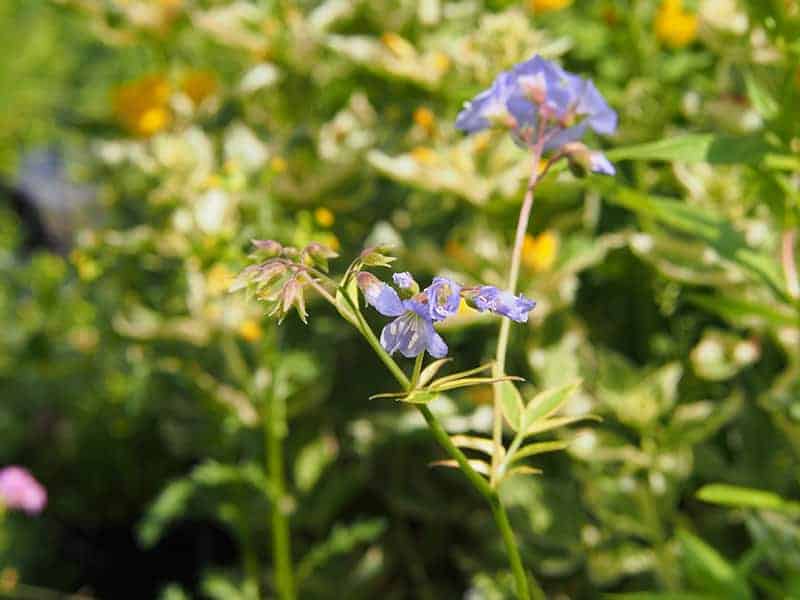Jacobs Ladder Plants for Sale - Buying & Growing Guide
Plant Care
Sunlight
Prefers full to partial shade conditions. Excessive sun exposure causes leaf scorch.
Watering
Don't allow the soil to become too dry or too soggy. Monitor soil regularly and water accordingly.
Fertilizing
Use a balanced fertilizer once at the beginning of the growing season and once at the end.
Jacob’s ladder gets its unique name from its pinnate leaf pattern, which resembles a ladder. There are two species of this plant. Polemonium reptans is a threatened species that grows natively in the northeastern U.S. and is not ideal for gardening. However, Polemonium caeruleum, which is native to temperate forests in Europe, is popular in home gardening for its pretty foliage and flowers and relatively low-maintenance care routine. Other notable Jacob’s ladder characteristics include:
- Ability to thrive in partial shade
- Hardy temperament, which allows it to grow well in most climates
- Ability to self-seed, making it easy to propagate
Planting and Care
Planting instructions
As this perennial plant is native to temperate woodlands, Jacob’s ladder does best in locations that mimic that environment. It prefers relatively neutral or slightly acidic soil that is rich in organic materials. Good drainage is more essential than soil pH, as soggy soil can cause root rot. Jacob’s ladder also does better in shady or semi-shady locations. Choose a spot in your garden with a canopy cover, or where light does not easily reach. When planting from seed, sow seeds directly into soil after the final frost. Cover seeds loosely with soil, and keep moist until seedlings sprout.
Watering and nutrients
The most important thing about watering Jacob’s ladder plants is staying consistent. They do not respond well to sporadic waterings, but instead like their soil to be consistently moist. However, waterlogged soil can lead to root rot, so make sure it’s planted in well-draining soil. How often you water your Jacob’s ladder plant depends on how much light it receives. Plants that are in darker locations need less watering, because moisture does not evaporate as quickly. Feed Jacob’s ladder plants with a balanced fertilizer once in early spring and again after flowers have bloomed.
Pollination
Jacob’s ladder attracts many common pollinators, including bees, butterflies, moths, and even hummingbirds. Their bell-shaped flowers, which come in various shades of blue, purple, pink, yellow, and white, attract the insects and birds that visit to drink the plant’s nectar and spread pollen between the plants. Once flowers are fertilized, they become capsules that produce seeds. These seeds then drop to the ground below, where they germinate, or are dispersed by wind and water.
Pruning
Pruning isn’t a necessity for the health of Jacob’s ladder plants, but an occasional trim will help keep it looking neat and attractive. Pruning leggy stems can maintain a uniform shape, and thinning out the plant will encourage airflow and help prevent fungal diseases. As Jacob’s ladder is a self-seeding plant, deadheading may be necessary if you do not want additional plants to grow in your garden. After the flowers are spent, cut stems back to the base so that they do not drop their seeds. This can also encourage the plant to rebloom before the growing season ends. In the spring, cut away any brown or dead stems to make way for new growth.
Pests, diseases, and animals
The most common diseases that affect Jacob’s ladder plants are fungal leaf spot and powdery mildew, both of which are caused by humid environments and too much moisture on the plants foliage. This is common among plants that live in shady conditions, because water on the leaves does not evaporate quickly. Avoid these issues by watering the plant at soil level and keeping leaves as dry as possible. Some of the pests that affect Jacob’s ladder plants are leaf miners, which can be treated with neem oil, and slugs, which can be eliminated with organic treatments. Jacob’s ladder is resistant to deer and rabbits.
Light
This plant grows best in partial shade or dappled shade. Ideally, plant it under the canopy of a tree with branches that aren’t too dense, allowing for dappled sunlight to come through and reach the Jabob’s ladder plant. Alternatively, you could grow this plant in a shady corner or in a spot that receives a few hours of morning sunlight but is shaded by a fence or building in the afternoon.
The reason this plant likes shade is that too much sun or heat will scorch the foliage. However, the plant doesn’t like to be in full shade as it requires some sun for the production of its flowers. This means partial shade is best, striking a good balance with some shade and some sun.
There are varieties of the plant that will cope with sunlight better than others. Generally speaking, the plants with dark green foliage fare better in direct sunlight, while the varieties with variegated leaves are more sensitive to sunlight and will require more shaded protection. The climate you are growing the plant in will also affect the amount of light it can handle; Jacob’s ladder growing in warmer regions will need a higher proportion of shade throughout the day than those grown in cooler climates.
Temperature
Jacob’s ladder is a hardy plant that does well in a wide range of climates. It will grow best in USDA hardiness zones 3 to 8, but it can also be grown anywhere up to zone 12, though care requirements will vary slightly depending on your climate.
If grown in zones 8 to 10, Jacob’s ladder will need to be grown in almost full shade. This will result in fewer flowers than those plants grown in dappled shade, but it will help to keep the plant cool. Jacob’s ladder does not like to get too hot, and therefore relies on the shade to lower the temperature by a few degrees and keep the plant happy.
If the plant gets too hot, it can wilt and die, while too much sun exposure will scorch the foliage. In cooler climates, the plant will act as an annual rather than a perennial. If you grow the plant in zones lower than zone 6, you can expect the plant to die off in the winter, but new plants will appear the following spring, where the previous plant self-seeded.
Propagation
There are several ways to grow new Jacob’s ladder plant, including planting from seed, division, and stem cuttings.
The plant is a prolific self-seeder, so if you are happy for new Jacob’s ladder plants to appear each year, then all you need to do is refrain from deadheading the spent flowers. Spent flowers that are left alone will develop and drop seeds, which will then provide new plants the following spring.
To prevent an overwhelming amount of new plants, you should deadhead most of the spent flowers but leave a few intact. If too many flowers do appear, you can simply thin them out to allow growing room. If you would prefer not to allow the plant to re-seed, you just need to deadhead all spent flowers.
You can also grow this plant from seed yourself, either directly in the ground, or get a head start by sowing the seeds indoors a few weeks before the final frost is expected. To sow the seeds outside, sprinkle them on moist soil after the last frost, and lightly cover with more soil.
Maintain moist soil, and once seedlings appear, they can be thinned out to around 18 inches between each new plant. The sow the seeds inside, follow the same process using a seed tray a few weeks earlier, and then transplant the seedlings outside once the risk of frost has passed.
The division is also a good method of propagating Jacob’s ladder. Once a plant has reached maturity, carefully dig it up and tease the roots apart, separating the plant into two. Tangled roots can be cut with sharp scissors, but take care to keep as many of the roots intact as possible. Once separated, plant the two Jacob’s ladders back into the ground.
It is possible to propagate this plant from stem cuttings, but this is not commonly done as the success rate for this is quite low.
Jacob’s Ladder Plant Varieties
There are two species of plants that are referred to as Jacob’s ladder plants; these are Polemonium caeruleum and Polemonium reptans. Polemonium caeruleum is native to woodlands in temperate regions of Europe and has been cultivated for use in gardens across the US. It is this Jacob’s ladder plant that is commonly found in nurseries and home gardens. It is rare to find this plant growing naturally in the wild. Meanwhile, Polemonium reptans is natively found in the northeast US and is a threatened plant species. As a means of ensuring this plant’s survival, transplanting wild specimens of this plant to home gardens is heavily discouraged. It is also not beneficial for the gardener to do so, as this species has a tendency to get very leggy and does not make a good garden plant. Within the Polemonium caeruleum species, several varieties exist, including the following.
Bressingham Purple

This Jacob’s ladder variety is a shade lover. It has variegated foliage in green with splashes of purple.
Stairway to Heaven

Another variegated Jacob’s ladder, this plant produces milky cream foliage.
FAQs
What are the ideal light conditions for Jacob’s ladder?
What are the ideal temperature conditions for Jacob’s ladder?
Jacob’s ladder is a hardy plant that can be grown in a range of climates. In USDA hardiness zones 6-10, Jacob’s ladder plants grow well in partial shade and return each year as perennials. In zones 11-12, the plant requires almost full shade to keep it from getting too hot. In zones 3-6, the plant acts as an annual, dying over the winter. In this case, allowing your Jacob’s ladder plant to self-seed will guarantee you have new blooms each year.
Is Jacob’s ladder plant an annual or perennial?
Technically, the Jacob’s ladder plant is perennial, but in certain climates it will act as an annual, dying over the winter if the roots freeze. However, in these circumstances, you can ensure you have Jacob’s ladder plants in your garden year after year by allowing the plant to self-seed, as new plants will replace the ones that die. In more moderate climates, with proper care, Jacob’s ladder can last several years.
Are there multiple varieties of Jacob’s ladder?
Yes, within the species Polemonium caeruleum, there are many varieties of different colors and sizes. Some popular Jacob’s ladder varieties are ‘Bambino Blue,’ a compact variety that has delicate, light blue flowers contrasted with yellow stamens; ‘Snow and Sapphires,’ a hardy variety that features blue flowers and variegated leaves; ‘Bressingham Purple,’ which thrives in shade and features light purple flowers, and ‘Stairway to Heaven,’ which has pink- or cream-tinged variegated foliage.
How do you propagate Jacob’s ladder?
The easiest way to propagate Jacob’s ladder plants is by letting the plant self-seed. Spent flowers will develop and drop seeds for new flowers the following spring. You can control the growth by deadheading most of the spent flowers, but leave a few intact to drop seeds. To propagate by division, dig up a mature plant and tease the roots apart, cutting tangled roots if necessary. Replant the divided plants in the ground.










